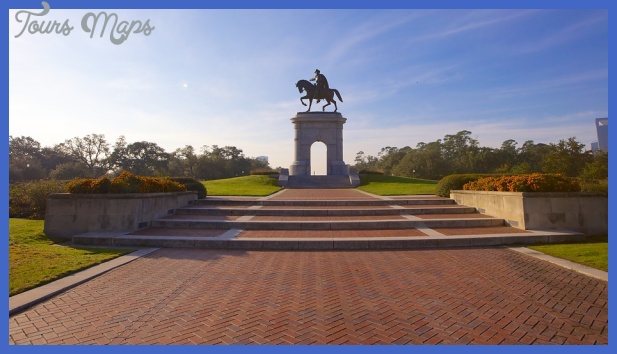The Depression, the New Deal, and World War II
Texas’s economic expansion continued in the 1920s. Cotton prices fluctuated, but other industries particularly oil experienced a boom. Although oil had been discovered at the Spindletop, near Beaumont, in 1901, Oklahoma was the industry’s center during the first two decades of the century. During World War I, rich fields in Electra, Texas, were found, followed by discoveries in Ranger and Burkburnet. By 1920 the industry had taken off, and Texas vied with Oklahoma for the position of top oil-producing state in the nation. Much of the money from the fields was channeled into education and public roads.
By the end of the 1920s, the Tejano community had grown substantially because of migration caused by the Mexican Revolution and agricultural and industrial growth. By 1930, Texas claimed 5,824,715 residents, 683,681 of whom were Mexican American. Attendant with the rising numbers, a growth in Tejano self-awareness would lead to even more political activities from 1921 through World War II’s end. During the 1920s, three events occurred that would greatly inform the Tejanos’ lives over the next decades: the white-primary act, the creation of the border patrol, and the beginnings of the Great Depression.
The white primary act actually an extension of boss rule practiced during the late nineteenth and early twentieth centuries was aimed primarily at black voters. However, this act disenfranchised most working-class citizens of Texas, regardless of color, by legally condoning a poll tax. It was not until the 1927 Supreme Court case Nixon v. Herndon that the law was repealed. Nonetheless, the Democratic Party, which at this time was pro-segregation, got around this by allowing only their white executive committee to decide their primaries. In the 1944 case Smith v. Allwright, the NAACP took an active role in overturning this practice.
In 1924 the United States Congress created the border patrol, a group assigned the responsibility of preventing smuggling and illegal entrance into the United States by land or sea. The border patrol for the southern part of the United States was located in El Paso, and in 1934, the first border-patrol academy opened in that same city. There, candidates learned marksmanship and riding. Along with the Texas Rangers, the border patrol monitored and strengthened the line between the United States and Mexico.
The border patrol was particularly active during Prohibition, when alcohol was smuggled across the border. Texas Protestants and fundamentalists had long favored the prohibition of alcohol. By 1895, 53 of the 239 counties in the state were dry, and another 79 counties had so-called blue laws, which restricted the sale of alcohol, especially on Sundays. For the most part,
African, Hispanic, and German Americans were against prohibition. In 1918 the federal government ratified the Twenty-First Amendment, prohibiting the sale of alcohol. This amendment was not repealed nationally until 1933 and in 1935 in Texas. The alcohol question was put under the control of local county and city governments.
Possibly the most significant event impacting Mexican American lives in Texas was the New York stock market crash of October 29, 1929. During the weeks following the crash, stock value continued to fall, signaling a 40 percent loss valued at $26 billion. For the nation, this signaled the beginning of the Great Depression. Initially, Texas seemed unaffected by this turn of events, but by 1931, even land-rich Texas had succumbed to the Depression’s sobering effects. As banks and businesses closed, and people were given their pink slips, menial jobs became attractive to many unemployed Anglos. This resulted in the forcible repatriation of many recently arrived Mexicans. During the 1930s, some 300,000 people went back to Mexico.
The U.S. and state governments were stretched to their limits and could not meet the needs of the people. Tejanos were among the first to lose their jobs. Local governments and private charities tried to step into the void left by the government, but the public coffers soon ran dry, and the industrial and private largess on which most charities depended for funding became nonexistent. Within the Mexican American communities, many mutualistas and other aid societies, like San Antonio’s Cruz Azul, failed and closed their doors.
Despite the failure of some of the mutualistas, Latinos in Texas continued to create organizations emphasizing education and equal rights. In 1929, Jose Tomas (J.T.) Canales, Andres de Luna, and other reformers met in Corpus Christi and founded the League of United Latin American Citizens (LULAC). LULAC’s strength was in part attributable to the fact that it was the product of a merger of four other well-established organizations: the Corpus Christi council of the Sons of America; the Alice council of the Sons of America; the Knights of America; and the Latin Americans Citizens League in the Rio Grande valley and Laredo. LULAC’S members included laborers, small-business owners, and lawyers. The group organized parent-teacher associations in Mexican American schools and filed suits against discriminatory practices. In the groundbreaking Salvatierra v. Del Rio ISD (1929), LULAC challenged the practice of segregated schools in Del Rio. Although the courts originally ordered an injunction in favor of Jesus Salvatierra, the complainant, the injunction was overruled on appeal. Nonetheless, this case constituted the first official challenge to the separate but equal practices in place in Texas’s education system.
After the beginning of the Great Depression, LULAC stepped into the void left by the dwindling mutualista organizations. In 1930 they testified before Congress regarding racism in Texas and the forced repatriation of many who had made their home in the state for years. Throughout the 1930s, they attempted to circumvent the poll tax by organizing poll-tax drives in different communities. After Franklin
D. Roosevelt’s election to the presidency, they fully supported his New Deal efforts and urged their constituents to do likewise.
Other challenges to discrimination were undertaken by labor unions. In 1933 workers at San Antonio’s Finck Cigar Company went on strike, protesting low wages and working conditions. Five years later, Emma Tenayuca led the workers of the Southern Pecan Shelling Company in San Antonio on strike. Tenayuca had been active in the Finck strike and was a member of the Worker’s Alliance, a national organization formed during the Great Depression by the Communist Party. Beyond working conditions and low wages, the pecan shellers were protesting a cut in wages. As the strike spread, 400 factories were picketed, and 700 arrests were made. While a settlement was reached, the San Antonio factory owners re-mechanized their factories shortly thereafter and, over the next three years, 10,000 workers were replaced.
In 1935, newly elected governor James Allred embraced Franklin Delano Roosevelt’s New Deal. Allred linked the New Deal’s Civilian Conservation Corps (CCC), Work Projects Administration (WPA), National Youth Administration (NYA), and Public Works Administration (PWA) with the preexisting local efforts toward work relief. Many Tejanos found employment through these organizations. Many Tejanos who signed up with the CCC reasoned that, since it was run by the army, it was, to an extent, immune to local politics and racism. The Federal Music Project, a WPA agency, employed Mexican musicians, who were then organized into Mexican folk bands and orchestras that performed in public live concerts and over the airwaves.
In 1935, Lyndon B. Johnson became the Texas director of the National Youth Administration, a program directed toward the education, counseling, and employment of young men and women between the ages of sixteen and twenty-five. The youngest director in the country at 27, Johnson worked ceaselessly to employ as many people as possible. In Johnson’s two years as its director, the program provided nearly 30,000 jobs, with the majority of jobs in south Texas going to Mexican Americans. For the most part, workers constructed roadside parks and bridges; in the city, employment was found in the construction of fountains and the repair of drainage systems. Training in skilled work included that obtained in a Laredo metal shop, and some workers helped repair National Guard glider planes in Houston. Some Tejanos even received college scholarships from this program. Jobs for women were provided in the fields of stenography and office work. By the end of Johnson’s two-year term, nearly as many women as men were employed by the NYA.
World War II brought other opportunities to Mexican Americans. During the war, the NYA set up eleven training facilities in the state that would direct youthful energies toward the war effort. This training included welding, sheet metal work, and radio repair. After successfully completing their training, the youths were sent out all over the country to work in industries providing support for the war. Mexican Americans also joined various military branches, although discrimination continued even among soldiers and officers.
In 1942, to contend with the depleted U.S. male population, the United States and Mexico instigated the Mexican Farm Labor Program, also known as the Bracero Program. This program allowed for the legal entry of Mexican workers into the United States for a specific amount of time, with the guaranteed wage of thirty cents per hour and the promise of humane treatment. However, Texas farm owners, who continued to use undocumented workers whom they could pay lower wages, did not initially sanction the agreement. Texas farm owners did not fully participate in the program until the 1950s.
In the meantime, problems arose when many documented workers did not return to Mexico after their time had expired. This was compounded by the refusal of many of the illegal migrants to leave. The U.S. government responded by instigating Operation Wetback in 1954. This program forcibly repatriated more than one million workers to Mexico. Nonetheless, an estimated 4.5 million Mexican workers were brought into the United States between 1942 and 1964, and most remained to become U.S. citizens.
Texas Vacations Photo Gallery
Maybe You Like Them Too
- The Best Cities To Visit in The World
- World’s 10 Best Places To Visit
- Coolest Countries in the World to Visit
- Travel to Santorini, Greece
- Map of Barbados – Holiday in Barbados














